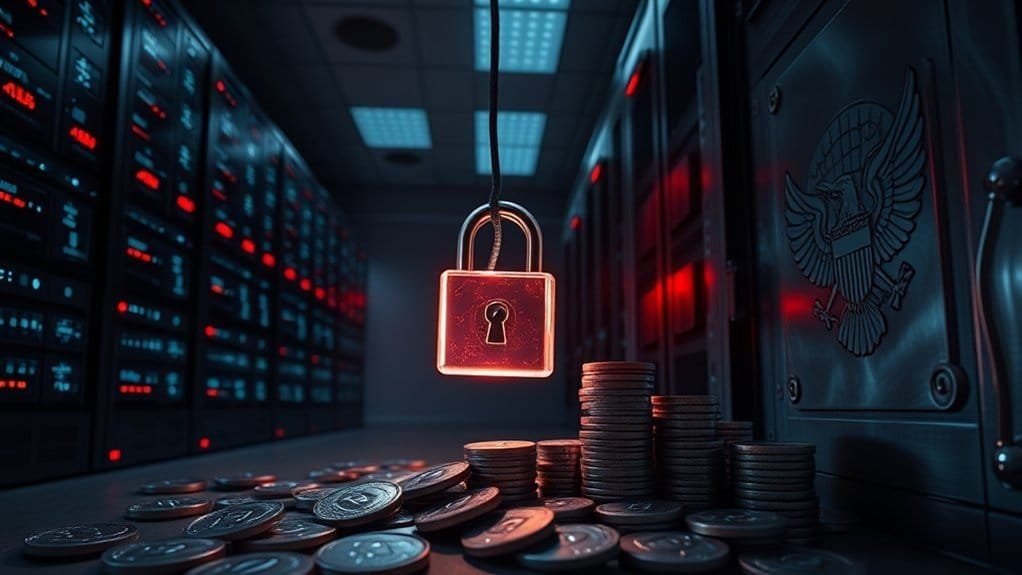The ByBit heist ripped $1.46 billion out of the crypto world, exposing security holes that even cold wallets and double authentication couldn’t patch. Hackers waltzed in through a developer’s workstation. North Korea’s Lazarus Group? Yeah, prime suspects. Cue paranoia, regulatory chaos, and security audits flying off the shelves. Even the SEC realized playing nice might be smarter than pretending the Wild West could last. Crypto trust? Shaky. Regulations are coming, like it or not—you’ll see what’s next.

Even in the wild world of crypto, a $1.46 billion hack is enough to make jaws drop and keyboards rattle. ByBit became infamous on February 21, 2025, when hackers snatched an eyewatering pile of cryptoassets during a supposedly harmless transfer from their cold to warm wallet. Routine, they said. Safe, they thought.
When $1.46 billion vanishes in a blur, even hardened crypto veterans feel a chill—routine turns ruinous at ByBit.
But the attackers weren’t your run-of-the-mill script kiddies—they compromised a developer’s workstation using social engineering and scored AWS tokens. North Korea’s Lazarus Group, never content to sit out a crypto bonanza, is the lead suspect. Blockchain analytics didn’t miss a beat making the call. State-sponsored cyberattacks are escalating worldwide, with actors like Lazarus leveraging sophisticated malware to target exchanges as part of broader geopolitical campaigns. The breach exposed how much even layered security measures like 2FA and cold wallet storage can be circumvented by persistent advanced threats.
The scale of the breach is a nightmare, not just for ByBit. Every crypto exchange now feels the icy finger of paranoia. The thieves blitzed right through security, proving once again: in crypto, you’re only as strong as your leakiest employee.
The aftermath? Constant anxiety about multisignature wallet tech and third-party services. Malware and clever phishing—pure hacker classics—are back in style. Gamers get malware for fun, crypto devs lose billions. Same tricks, different stakes.
Now comes the circus act of regulation. The SEC, usually the big bad wolf, has been unusually friendly lately. If anything, that’s a mixed blessing. Some say this is the green light for innovation. Others see it as letting the foxes run the henhouse.
The US making nice with Europe on regulations could squeeze startups out of comfy gray areas. Unregulated operations? Yeah, open invitation for chaos. The lack of clear regulations in 58% of countries creates regulatory uncertainty that complicates compliance and increases legal risks for crypto payment providers.
Trust took a nosedive across DeFi. Investors are skeptics. Security audits? Suddenly hotter than meme coins. But exchanges bonded—standing by ByBit, flexing for the cameras. Stability is looking fragile, especially with shady operators ducking oversight, ready to tip the whole market over.
On the bright side, blockchain analytics are hunting stolen coins. Chainalysis joined the party. Bounties, collaborative tracking, everyone wants their hero badge.
Too bad hackers use money laundering-as-a-service now. Do it fast or kiss those coins goodbye. In this arena, slow responders lose. Every time.
Frequently Asked Questions
What Security Measures Can Individual Crypto Investors Take Against Exchange Hacks?
Crypto investors get paranoid, and for good reason. Hackers salivate over exchange wallets like wolves spotting a stray sheep.
Investors crank up two-factor authentication, set up account alerts, and stash coins in hardware wallets—because trusting exchanges alone? That’s just asking to be robbed. Some even bother with withdrawal whitelists and encryption.
Sure, phishing scams lurk everywhere, so investors triple-check links, or else it’s “goodbye bitcoin, hello regret.”
Security paranoia basically becomes a lifestyle.
How Can Victims of Crypto Heists Recover Their Stolen Assets?
Stolen crypto? Good luck, but there’s a shot.
Victims usually scramble to hire blockchain forensics teams—think Chainalysis, Elliptic, whatever can follow digital breadcrumbs.
Cops and regulators get dragged into the mess, and lawyers start chasing freeze and confiscation orders.
International drama kicks off—crypto bounces fast between countries.
There are fancy recovery tools and insurance, sure, but recovery is rare.
Fast action helps; delay, and your coins are probably gone forever.
Which Agencies Investigate International Crypto-Related Crimes?
Big mess? Meet a multi-agency squad.
The FBI plunges in initially, sniffing out fraud and digital crime like a hound with a badge.
The IRS wants their tax cut—always lurking.
DEA handles drug money in crypto.
DOJ, Money Laundering section? Unyielding.
And don’t forget NCET—fancy name, lots of paperwork.
Mix in the Computer Crime team, the U.S. Attorneys, plus national security.
Basically, everyone’s got a finger in the crypto pie.
Damn crowded.
Are Decentralized Exchanges Safer Than Centralized Ones Like Bybit?
People love to argue about whether decentralized exchanges are “safer” than centralized ones.
Truth bomb: both have giant red flags.
Centralized exchanges? Yeah, they get hacked. A lot. You hand over your crypto, cross your fingers, and hope the suits running things know what they’re doing.
In DEX land, you own your coins but risk losing everything to a buggy smart contract.
It’s a weird trade-off—pick your poison.
No such thing as “safe.”
What Are the Risks of Storing Cryptocurrencies on Exchanges?
Storing crypto on exchanges is like leaving your cash in the middle of Times Square. Hackers love them.
Sometimes security is a joke, which leads to big, embarrassing losses. Lose your password? Good luck. That exchange might freeze everything, just because.
Oh, and those private keys? Not yours. Regulations can change overnight, shutting things down or locking you out.
Extra fees show up out of nowhere. Basically, users trade convenience for a truckload of risk.

